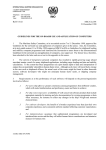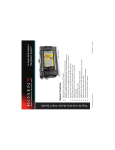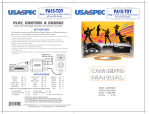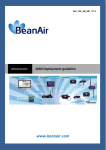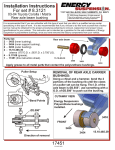Download Analysis of a Car Stereo Interface
Transcript
Analysis of a Car Stereo Interface Timothy Chan [email protected] Description Figure 1: Toyota Corolla (~2005) Car Stereo Interface The Toyota Corolla is a common car seen very often in the streets of Vancouver. Like almost all other vehicles, this car comes with a standard car stereo, with support for AM/FM radio and CD playback. The interface for controlling this system is shown above. There are some features of this interface that is not intuitive to the common user, and are generally learned over trial and error, or the rare foray to the user manual, if such thing exists. In this report I will discuss three different aspects of this interface that may not be intuitive to the user, and propose a redesign that will help address the issue. 2. Analysis 2.1 Functionality The interface allows for powering on and off the entire stereo, and toggling between the car's radio and CD player. The radio has a typical 'scan' feature that automatically finds signals strong enough to be received intelligibly. It has six pre-set channels, which are separately grouped into one AM and two FM groups, which are toggled by the AM'FM button. The CD button toggles the CD player mode, with basic features such as Random mode, Repeat mode, and moving forward and backwards through tracks. An additional feature of this interface is to control the Bass, Treble, Left/Right balance and Forward/Back balance of the car stereo, which allows for different weighting of audio output in the various speakers in the car. 2.2 Stakeholders Since the interface comes stock with the Corolla, the potential user base is extremely large, from teenagers first learning to drive to the elderly. The level of expertise and capability to learn new ideas vary greatly from one user to another. The user's understanding of the system does not directly impact the ability for them to use the vehicle, but it could indirectly affect them in their ability to get updates on traffic, weather, or perhaps to keep from falling asleep on a long drive. 2.3 Requirements Functional Requirements include: - Ability to turn off the system reliably and easily, in the event that the driver needs total focus on the road. - Simple interface that allows for typical actions to be carried out while driving (simple actions(twist knob)/single button presses) 2.4 Interface Problems 2.4.1 Non intuitive access/modification of Audio Settings In order to change the built-in equalizer and output balance of the car stereo, one must depress the right twist-knob, such that the display shows BAS, TRE, BAL and FAD sequentially. When the appropriate setting is found, the right knob is turned clockwise or anticlockwise to increase or decrease the value respectively. Although there is a label of "AUDIO CONTROL" with PUSH MODE written underneath (see figure 2 below), it is not immediately obvious what that signifies, especially as the left knob controls the master volume for the system. Twisting the knob without first depressing the knob does nothing, further adding to the confusion. Figure 2: Right twist-knob for Audio Settings 2.4.2 Changing Clock displayed time The clock is set by holding down the "AM'FM" button, while pressing the preset buttons 1, 2 or 3, depending on whether the Hour, Minute, or Default "Set" is to be used. This would not be obvious to those that are not used to laptop computers with extra "function" keys, and even for those that do use laptops, may take some time to discover. Holding AM'FM toggles between displaying the current time and the current radio frequency, which is also not intuitive and was only discovered through trial and error. Figure 3: Note the CLOCK label above the AM'FM button and the small H, M, and SET labels 2.4.3 BAS/TRE/BAL/FAD not descriptive of their function Under the Audio Control settings BAS/TRE/BAL/FAD represents Bass, Treble, Left/Right Balance and Front/Back Balance respectively. These are not obvious to a first time user, and not every user will be able to identify the purpose of the left/right or front/back balances appropriately, especially the latter, as it is harder to identify the effects when seating in the driver's or front passenger seat. Furthermore, the letters BAL and FAD do not immediately give users the association to the purpose of that setting. Figure 4: Showing the BAL setting screen 3 Solution 3.1 Design 3.1.1 Non intuitive access/modification of Audio Settings Instead of a single twist-knob that controls all four different audio settings, four different sliders can be used on the interface, each of which would adjust a different property. Four horizontal sliders can occupy the same amount of space as taken up currently by the printed label and the twist knob. Each of them can be labeled clearly with their function, and would have the advantage of being changed all at once. 3.1.2 Changing Clock displayed time The most obvious way to allow a user to change the time shown would be to add two buttons, one of which increments the hour by one, and the other increments the minutes by one. The buttons can be labeled appropriately to reduce confusion, and not having multiple options for a single button would allow the user to have a proper mental mapping for future use. 3.1.3 Three-letter display The simplest solution would be to increase the number of letters that can be displayed by the screen. Doubling the amount of letters displayed to six letters allow the full words "BASS", "TREBLE", "LR_BAL", and "FB_BAL" to be displayed, although the latter two may not be any more indicative to a new user. However, six letters were chosen because the change to a full pixel-based LED screen would be an extreme increase in costs, whereas this strikes a better compromise between the two. 3.2 Cost Estimate An estimate for the changes: - Interface Designer @ $70/hr for 40 hours to redesign physical interface: $1400 - Electrical Engineer @ $60/hr for 30 hours to implement new wiring of interface: $1800 - Software Engineer @ $50/hr for 40 hours to implement new software for 6-letter screen: $2000 - Additional costs: New (costlier) display, More complicated physical components. Total Implementation Cost: $5200 plus parts costs.





